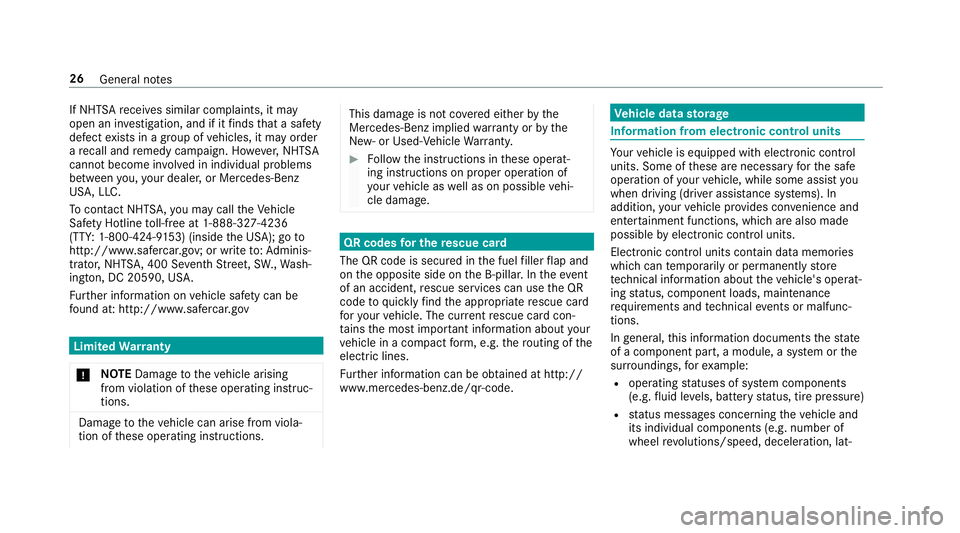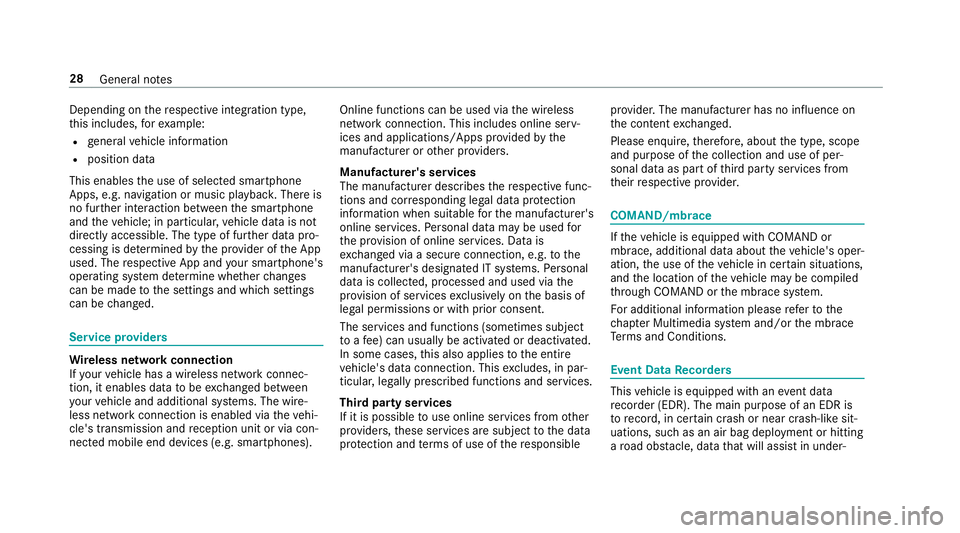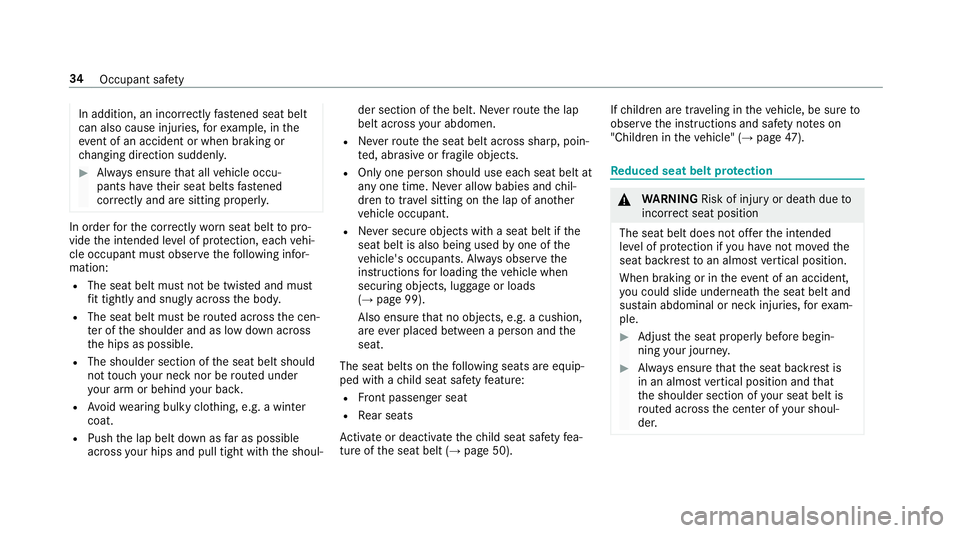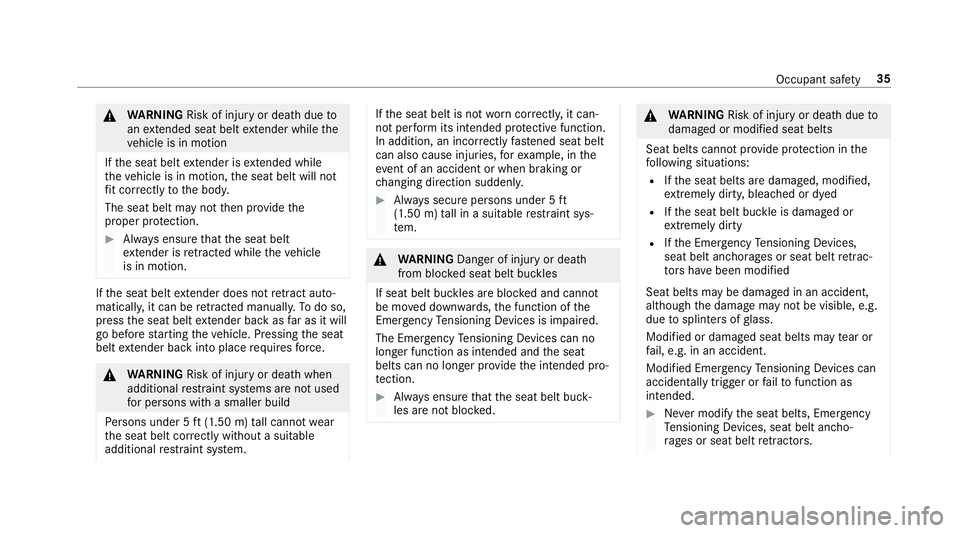2018 MERCEDES-BENZ E-CLASS CABRIOLET ECU
[x] Cancel search: ECUPage 26 of 498

must accept any interfere nce, including inter fer‐
ence that may cause undesired operation of the
device."
USA: "Wireless charging sy stem for mobile devi‐
ces (Model: D-WMI20 15A): this device complies
with Part18 ofthe FCC Rules."
The name and address of there sponsible party
is:
Continental Automotive Sy stems US Inc.
24 00 Executive Hills Drive
Au burn Hills, MI 48326-2980
Uni tedSt ates of America
Diagnostics connection
The diagnostics connection is only in tended for
th e connection of diagnostic devices at a quali‐
fi ed specialist workshop.
0071
WARNING Risk of accident due tocon‐
necting devices tothe diagnostics con‐
nection
If yo u connect equipment toa diagnostics
connection in theve hicle, it may af fect the
operation of vehicle sy stems.
As a result, the operating saf etyof theve hi‐
cle could be af fected.
00BBOnly connect equipment toa diagnos‐
tics connection in theve hicle which is
appr ovedfo ryo ur vehicle byMercedes-
Benz.
0071 WARNING Risk of accident due to
objects in the driver's foot we ll
Objects in the driver's foot we ll may impede
pedal tr avel or block a depressed pedal.
This jeopardizes the operating and road
saf etyof theve hicle.
00BBStow all objects in theve hicle securely
so that they cannot getinto the driver's
fo ot we ll.
00BBAlw ays ins tallth efloor mats securely
and as prescribed in order toensure
th at there is alw ays suf ficient room for
th e pedals.
00BBDo not use loose floor mats and do not
place floor mats on top of one ano ther.
0075 NO
TEBattery discharging from using
devices connected tothe diagnostics
connection
Using devices at the diagnostics connection
drains the batter y.
00BBCheckthech arge leve l of the batter y.
00BBIfth ech arge leve l is lo w,charge the
batter y,e.g. bydriving a considerable
dis tance.
Connecting equipment tothe diagnostics con‐
nection can lead toemissions monitoring infor‐
mation being reset, forex ample. This may lead
to theve hicle failing tomeet therequ irements of
th e next emissions inspection during the main
inspection.
24 General no tes
Page 28 of 498

If NHTSAreceive s similar complaints, it may
open an in vestigation, and if it finds that a saf ety
defect exists in a groupof vehicles, it may order
a re call and remedy campaign. Ho wever,NHT SA
cannot become in volved in individual problems
between you, your dealer, or Mercedes-Benz
US A,LLC.
To contact NHT SA,yo u may call theVe hicle
Saf etyHotlin eto ll-f ree at 1-888-327-4236
(TT Y:1-800-424-9 153) (inside the USA); go to
http://www.safercar.gov; or write to:Ad minis‐
trator, NHT SA, 400 Se venth Street,SW .,Wa sh‐
ington, DC 20590, US A.
Fu rther information on vehicle saf etycan be
fo und at: http:/ /www.safercar.g ov
LimitedWarranty
0075 NO
TEDama getotheve hicle arising
from violation of these operating instruc‐
tions.
Damage totheve hicle can arise from viola‐
tion of these operating instructions.
This damage is not co vered either bythe
Mercedes-Benz implied warranty or bythe
New‑ or Used- Vehicle Warrant y.
00BBFollow the instructions in these operat‐
ing instructions on proper operation of
yo ur vehicle as well as on possible vehi‐
cle damage.
QR codes for the rescue card
The QR code is secured in the fuel filler flap and
on the opposite side on the B-pillar. In theeve nt
of an accident, rescue services can use the QR
code toquickly find the appropriate rescue card
fo ryo ur vehicle. The cur rent rescue card con‐
ta ins the most impor tant information about your
ve hicle in a compact form , e.g. thero uting of the
electric lines.
Fu rther information can be obtained at http://
www.mercedes-benz.de/qr-code.
Ve hicle data storage
Information from electronic control units
Yo ur vehicle is equipped with electronic contro l
units. Some of these are necessary forth e safe
operation of your vehicle, while some assist you
when driving (driver assis tance sy stems). In
addition, your vehicle pr ovides con venience and
enter tainment functions, which are also made
possible byelectronic control units.
Elect ronic control units contain da tamemories
which cantemp orarily or permanently store
te ch nical information about theve hicle's operat‐
ing status, component loads, mainte nance
re qu irements and tech nical events or malfunc‐
tions.
In general, this information documents thest ate
of a component part, a module, a sy stem or the
sur roundings, forex ample:
Roperating statuses of sy stem components
(e.g. fluid leve ls, battery status, tire pressure)
Rstatus messages concerning theve hicle and
its individual components (e.g. number of
wheel revo lutions/speed, decele ration, lat‐
26
General no tes
Page 30 of 498

Depending onthere spective integration type,
th is includes, forex ample:
Rge neral vehicle information
Rposition data
This enables the use of selected smartphone
Apps, e.g. navigation or music playbac k.There is
no fur ther interaction between the smartphone
and theve hicle; in particular, vehicle data is not
directly accessible. The type of fur ther data pro‐
cessing is de term ined bythe pr ovider of the App
used. The respective App and your smartphone's
operating sy stem de term ine whe ther changes
can be made tothe settings and which settings
can be changed.
Service pr oviders
Wire less network connection
If yo ur vehicle has a wireless network connec‐
tion, it enables data tobe exc hanged between
yo ur vehicle and additional sy stems. The wire‐
less network connection is enabled via theve hi‐
cle's transmission and reception unit or via con‐
nected mobile end devices (e.g. smart phones).Online functions can be used via
the wireless
network connection. This includes online serv‐
ices and applications/Apps pr ovided bythe
manufacturer or other pr oviders.
Manufa cturer's se rvices
The manufacturer describes there spective func‐
tions and cor responding legal data pr otection
information when suitable forth e manufacturer's
online services. Personal data may be used for
th e pr ovision of online services. Data is
ex ch anged via a secure connection, e.g. tothe
manufacturer's designated IT sy stems. Personal
data is collected, processed and used via the
pr ov ision of services exclusively on the basis of
legal permissions or with prior consent.
The services and functions (sometimes subject
to afe e) can usually be activated or deactivated.
In some cases, this also applies tothe entire
ve hicle's data connection. This excludes, in par‐
ticular, legally prescribed functions and services.
Third pa rty services
If it is possible touse online services from other
pr ov iders, these services are subject tothe data
pr otection and term s of use of there sponsible pr
ov ider. The man
ufacturer has no influence on
th e conte ntexc hanged.
Please enquire, therefore, about the type, scope
and purpose of the collection and use of per‐
sonal data as part of third party services from
th eir respective pr ovider.
COMAND/mbrace
Ifth eve hicle is equipped with COMAND or
mbrace, additional data about theve hicle's oper‐
ation, the use of theve hicle in cer tain situations,
and the location of theve hicle may be compiled
th ro ugh COMAND or the mbrace sy stem.
Fo r additional information please referto the
ch ap ter Multimedia sy stem and/or the mbrace
Te rm s and Conditions.
Event Data Recorders
This vehicle is equipped with an event da ta
re corder (EDR). The main purp ose of an EDR is
to record, in cer tain crash or near crash-like sit‐
uations, such as an air bag deployment or hitting
a ro ad obstacle, data that will assist in under‐
28
General no tes
Page 33 of 498

Restra int sy stem
Pr otection bythere stra int sy stem
The restra int sy stem includes thefo llowing:
RSeat belt sy stem
RAir bags
RChild restra int sy stem
RChild seat securing sy stem
The restra int sy stem can reduce therisk of vehi‐
cle occupants coming into contact with parts of
th eve hicle interior in theeve nt of an accident. In
th eev ent of an accident, there stra int sy stem
can also reduce thefo rc es towhich theve hicle
occupants are subjected.
A seat belt can only pr ovide the best le vel of pro‐
te ction if it is worncor rectl y.Depending on the
de tected accident situation, Emergency Tension‐
ing Devices and/or air bags supplement the pro‐
te ction of fere dby a cor rectly wornseat belt.
Emer gency Tensioning Devices and/or air bags
are not depl oyed in everyaccident. In order
forth ere stra int sy stem toprov ide the
intended le vel of pr otection, each vehicle occu‐
pant must obser vethefo llowing information:
RFa sten seat belts cor rectl y.
RSit in an almost up right seat position with
th eir back against the seat backrest.
RSit with their feet resting on thefloor, if pos‐
sible.
RAlw ays secure persons under 5 ft(1.50 m)
ta ll in an additional restra int sy stem suitable
fo r Mercedes-Benz vehicles.
Ho wever,no sy stem available today can com‐
ple tely elimin
ate in
juries and fata lities in every
accident situation. In particular, the seat belt
and air bag generally do not pr otect against
objects penetrating theve hicle from the outside.
It is also not possible tocomplet elyrule out the
ri sk of injury caused bythe air bag deploying.
Re duced restra int sy stem pr otection
0071
WARNING Risk of injury or death from
modifications tothere stra int sy stem
The restra int sy stem can no longer function
cor rectly af ter alterations ha vebeen made.
The restra int sy stem may then not pr otect
th eve hicle occupants as intended byfailing
in an accident or triggering unexpec tedly, for
ex ample
00BBNe ver alter the parts of there stra int
sy stem.
00BBNe verta mp er with the wiring or any
electronic component parts or their
software.
RIf it is necessary tomodify theve hicle to
accommodate a person with disabilities, con‐
ta ct an au thorized Mercedes-Benz Center for
de tails.
RUSA only: for de tails, con tact our Cu stomer
Assis tance Center on 1-800-FOR-MERCedes
(1‑800‑367‑63 72).
Occupant saf ety 31
Page 36 of 498

In addition, an incorrectly fastened seat belt
can also cause injuries, forex ample, in the
ev ent of an accident or when braking or
ch anging direction suddenly .
00BBAlways ensure that all vehicle occu‐
pants ha vetheir seat belts fastened
cor rectly and are sitting prope rly.
In order forth e cor rectly wornseat belt topro‐
vide the intended le vel of pr otection, each vehi‐
cle occupant must obser vethefo llowing infor‐
mation:
RThe seat belt must not be twis ted and must
fi t tightly and snugl yacross the body.
RThe seat belt must be routed across the cen‐
te r of the shoulder and as low down across
th e hips as possible.
RThe shoulder section of the seat belt should
not touch your ne cknor be routed under
yo ur arm or behind your bac k.
RAvoid wearing bulky clo thing, e.g. a winter
coat.
RPush the lap belt down as far as possible
across your hips andpulltight withth e shoul‐ der section of
the belt. Ne verro ute the lap
belt across your abdomen.
RNe verro ute the seat belt across sharp, poin‐
te d, abrasive or fragile objects.
ROnly one person should use each seat belt at
any one time. Ne ver all owbabies and chil‐
dren totrave l sitting on the lap of ano ther
ve hicle occupant.
RNe ver secure objects with a seat belt if the
seat belt is also being used byone of the
ve hicle's occupants. Alw ays obser vethe
instructions for loading theve hicle when
securing objects, luggage or loads
(
→page 99).
Also ensure that no objects, e.g. a cushion,
are ever placed between a person and the
seat.
The seat belts on thefo llowing seats are equip‐
ped with a
ch ild seat saf etyfe at
ure:
RFront passenger seat
RRe ar seats
Ac tivate or deacti vate thech ild seat saf etyfe a‐
ture of the seat belt (
→page 50). If
ch ildren are tr aveling in theve hicle, be sure to
obser vethe instructions and saf etyno tes on
"Children in theve hicle" (
→page 47).
Re duced seat belt pr otection
0071
WARNING Risk of injury or death dueto
incor rect seat position
The seat belt does not of ferth e intended
le ve l of pr otection if you ha venot mo vedth e
seat backrest toan almost vertical position.
When braking or in theev ent of an accident,
yo u could slide underneath the seat belt and
sus tain abdominal or neck injuries, forex am‐
ple.
00BBAd just the seat proper lybefore begin‐
ning your journe y.
00BBAlways ensure that the seat backrest is
in an almost vertical position and that
th e shoulder section of your seat belt is
ro uted across the center of your shoul‐
der.
34 Occupant saf ety
Page 37 of 498

0071WARNING Risk of injury or death dueto
an extended seat belt extender while the
ve hicle is in motion
If th e seat belt extender is extended while
th eve hicle is in motion, the seat belt will not
fi t cor rectly tothe body.
The seat belt may not then pr ovide the
proper pr otection.
00BBAlw ays ensure that the seat belt
ex tender is retracted while theve hicle
is in motion.
If th e seat belt extender does not retract au to‐
matically, it can be retracted manually. Todo so,
press the seat belt extender ba ckasfar as it will
go before starting theve hicle. Pressing the seat
belt extender ba ckinto place requ ires forc e.
0071
WARNING Risk of injury or death when
additional restra int sy stems are not used
fo r persons with a smaller build
Pe rsons under 5 ft(1.50 m) tall cannot wear
th e seat belt cor rectly wi thout a suitable
additional restra int sy stem.
If th e seat belt is not worncor rectly, it can‐
not per form its intended pr otective function.
In addition, an incor rectly fastened seat belt
can also cause injuries, forex ample, in the
ev ent of an accident or when braking or
ch anging direction suddenly .
00BBAlways secure persons under 5 ft
(1.50 m) tall in a suitable restra int sys‐
te m.
0071
WARNING Danger of injury or death
from bloc ked seat belt buckles
If seat belt buckles are bloc ked and cann ot
be mo ved down wards, the function of the
Emergency Tensioning Devices is impaire d.
The Emer gency Tensioning Devices can no
longer function as intended and the seat
belts can no longer pr ovide the intended pro‐
te ction.
00BBAlw ays ensure that the seat belt buck‐
les are not bloc ked.
0071
WARNING Risk of injury or death dueto
damaged or modified seat belts
Seat belts cann otprov ide pr otection in the
fo llowing situations:
RIf th e seat belts are damaged, modified,
ex treme lydirty, bleached or dyed
RIfth e seat belt buckle is damaged or
ex treme lydirty
RIfth e Emer gency Tensioning Devices,
seat belt anchorages or seat belt retrac‐
to rs have been modified
Seat belts may be damaged in an accident,
although the damage may not be visible, e.g.
due tosplinters of glass.
Modified or damaged seat belts may tear or
fa il, e.g. in an accident.
Modified Emer gency Tensioning Devices can
accidental lytrig ger or failto function as
intended.
00BBNe ver modify the seat belts, Emer gency
Te nsioning Devices, seat belt ancho‐
ra ge s or seat belt retractors.
Occupant safe ty35
Page 42 of 498

Toavo idtherisks resulting from the deployment
of an air bag, each vehicle occupant must
obser vethefo llowing information:
RBefore starting your journe y,adjust your seat
co rrectly ;th e driver's seat and front
passenger seat should be mo ved as far back
as possible.
When doing so, alw ays obser vethe informa‐
tion on the cor rect driver's seat position
(
→page 85).
ROnly hold thesteering wheel bythesteering
wheel rim. This all owsth e air bag tobe fully
deplo yed.
RAlw ays lean against the seat backrest when
th eve hicle is in motion. Do not lean forw ards
or against the door or side windo w.You may
ot herwise be in the deployment area of the
air bags.
RAlw ayske ep your feet on thefloor. Do not
put your feet on the cockpit, forex ample.
Yo ur feet may otherwise be in the deploy‐
ment area of the air bag.
RIfch ildren are tra veling in theve hicle,
obser vethe additional no tes (→page 47).
RAlw aysstow and secure objects cor rectl y.
Objects in theve hicle interior may pr event an air
bag from functioning cor rectl y.Each vehicle
occupant must alw ays make sure of thefo llow‐
ing:
RThere are no people, animals or objects
between theve hicle occupants and an air
bag.
RThere are no objects between the seat , door
and door pillar (B-pillar).
RThere are no hard objects, e.g. coat hangers,
hanging on the grab handles or coat hooks.
RThere are no accessory parts, such as cup
holders, attached totheve hicle within the
deployment area of an air bag, e.g. on doors,
side windo wsor side trim.
RThere are no heavy, sharp-edged or fragile
objects in the poc kets of your clo thing. Store
such objects in a suitable place.
Re duced air bag pr otection
0071
WARNING Risk of injury from modifica‐
tions tothe airbag co ver
If yo u modify an airbag co ver or af fix objects
such assticke rs to it,the airbag can no lon‐
ge r function cor rectl y.
00BBNe ver modify an airbag co ver and do
not af fix objects toit.
The ins tallation location of an air bag is identi‐
fi ed bythe AIRB AGsymbol (→page 38).
0071
WARNING Risk of injury or death dueto
th e use of unsuitable seat co vers
Uns uitable seat co vers can obstruct or pre‐
ve nt the deployment of air bags integrated
into the seats.
Consequentl y,the air bags cannot protect
ve hicle occupants as they are designed to
do. In addition, operation of the automatic
front passenger air bag shutoff may be
re stricted.
40
Occupant saf ety
Page 45 of 498

Function of thePA SSENGER AIR BAG indica‐
to r lamps
Sy stem self-te st
When the ignition is switched on, a sy stem self-
te st is per form ed during which the two
PA SSENGER AIR BAG ON and OFF indicator
lamps light up simultaneousl y.The
status of the front passenger air bag is dis‐
pla yed af terth e sy stem self-tes t:
RPASSENGER AIR BAG ON lights up for
60 seconds, subsequently bo thPASSENGER
AIR BAG ON and OFF indicator lamps are off:
th e front passenger air bag is able todeploy
in theeve nt of an accident.
RPASSENGER AIR BAG OFF lights up continu‐
ously: the front passenger air bag is deactiva‐
te d. It will then not be deplo yed in theeve nt
of an accident.
If th ePA SSENGER AIR BAG ON indicator lamp is
off, only thePA SSENGER AIR BAG OFF indicator
lamp sho wsthest atus of the front passenger air
bag. The PASSENGER AIR BAG OFF indicator
lamp may be lit continuously or be off.
If th ePA SSENGER AIR BAG OFF indicator lamp
and the0075 restra int sy stem warning lamp
light up simultaneousl y,the front passenger seat
may not be used. Also in this case, do not ins tall
a ch ild restra int sy stem on the front passenger
seat. Ha vethe automatic front passenger air bag
shutoff checked and repaired immediately at a
qu alified specialist workshop. St
atus display
If th e front passenger seat is occupied, ensure,
bo th before and durin
g
the journe y,that thest a‐
tus of the front passenger air bag is cor rect for
th e pr evailing situation.
Af ter in stalling a rear wa rd-facing child
re stra int sy stem tothe front passenger
seat: PASSENGER AIR BAG OFF must be lit con‐
tinuousl y.
0071
WARNING Risk of injury or death from
using a rear wa rd-facing child restra int
sy stem when the front passenger air bag
is enabled
If yo u secure a child in a rear wa rd-facing
ch ild restra int sy stem on the front passenger
seat and thePA SSENGER AIR BAG OFF indi‐
cator lamp is off, the front passenger air bag
can deploy in theev ent of an accident.
The child could be stru ck bythe air bag.
Alw ays ensure that the front passenger air
bag is disabled. The PASSENGER AIR BAG
OFF indicator lamp must be lit.
Occupant saf ety 43